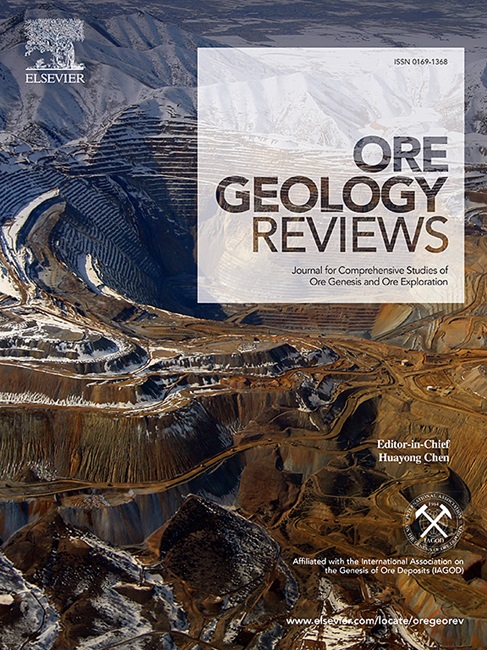中国西部白龙山伟晶岩中的锂-铷矿床成因研究:来自年代学、流体包裹体和 H-O 同位素分析的证据
IF 3.2
2区 地球科学
Q1 GEOLOGY
引用次数: 0
摘要
白龙山伟晶岩矿床位于中国西北西昆仑造山带,是一个新发现的超大型锂-铷(Be-Ta-Nb)稀有金属矿床。由于此类稀有元素伟晶岩的成矿过程是复杂的岩浆-热液过程,因此研究成矿流体的演化过程和来源对分析矿床成因十分必要。本研究测定了蕈云母和生物云母的 40Ar/39Ar 高原年龄,分别为 171.36 ± 1.87 Ma 和 172.39 ± 1.66 Ma,表明热液成矿时间约为 170 Ma。根据矿物组合的分带性质,将白龙山地区划分为四个带和段(Ⅰ-Ⅳ),即白云母-石英-锂电气石带(AQT,Ⅰ段)、白云母-石英-云母带(AQM,Ⅱ段)、白云母-石英-钠长石带(AQS,Ⅲ段)和钠长石-石英带(SQ,Ⅳ段)。其中,AQS 和 SQ 是主要的含矿区。从石英和闪长岩中发现的流体包裹体来看,其类型包括富气相(V 型)、富液相(L 型)、含子矿物三相(S 型)和含二氧化碳相(C 型)。在第一阶段,V 型和 S 型流体包裹体的均匀温度在 365 至 415 ℃ 之间变化,相应的盐度分别为 8.5 至 12.9 和 44.8 至 47.2 wt% NaCl 当量。在第Ⅱ阶段,L 型包裹体的均匀温度和盐度分别为 315-365 ℃ 和 9.9-13.3 wt% 等量氯化钠,而在第Ⅲ和第Ⅳ阶段,L 型和 S 型流体包裹体的均匀温度介于 235 和 335 ℃ 之间,盐度分别为 7.2-12.3 和 32.1-37.0 wt% 等量氯化钠。此外,C 型夹杂物的均匀温度和盐度分别为 235-320 ℃ 和 4.9-10.6 wt% NaCl 当量。激光拉曼结果表明,成矿阶段的流体为 H2O-NaCl-CO2-CH4 系统。根据均相温度和盐度结果,计算出从第三阶段到第四阶段的流体捕获压力为 280-150 兆帕,捕获深度为 6 千米。此外,H-O 同位素结果表明,早期成矿流体主要为岩浆热液,而后期(第四阶段)成矿流体可能混有少量陨水。随后流体的不溶性可能是造成矿物排出和沉淀的因素之一。本文章由计算机程序翻译,如有差异,请以英文原文为准。

Genesis studies of Li–Rb deposits in pegmatites from Bailongshan, western China: Evidence from chronology, fluid inclusions, and H–O isotope analysis
The Bailongshan Pegmatite deposit, located in the West Kunlun Orogenic Belt, Northwest China, is a newly discovered, super-large Li–Rb (Be–Ta–Nb) rare-metal deposit. Since complex magmatic-hydrothermal processes are responsible for the mineralization of such rare-element pegmatites, it is desirable to study the evolution and sources of ore-forming fluids to analyze the genesis of ore deposits. In this study, the 40Ar/39Ar plateau ages of muscovite and biotite were determined to be 171.36 ± 1.87 and 172.39 ± 1.66 Ma, respectively, indicating that the duration of hydrothermal mineralization was approximately 170 Ma. Based on the zonal nature of the mineral assemblage, the Bailongshan area was divided into four zones and stages (I–IV), namely the albite–quartz–lithium tourmaline (AQT, stage I), albite–quartz-bearing mica (AQM, stage II), albite–quartz–spodumene (AQS, stage Ⅲ), and spodumene–quartz (SQ, stage IV) zones. Among these, AQS and SQ were the main ore-bearing areas. In terms of the fluid inclusions found in quartz and spodumene, the different types include a gas-rich phase (V-type), a liquid-rich phase (L-type), a daughter mineral-bearing three-phase (S-type), and a carbon dioxide-bearing phase (C-type). In stage I, the homogeneous temperatures of the V- and S-type fluid inclusions varied from 365 to 415 °C, while their corresponding salinities were 8.5–12.9 and 44.8–47.2 wt% NaCl equiv., respectively. In stage II, the homogeneous temperature and salinity of the L-type inclusions were 315–365 °C and 9.9–13.3 wt% NaCl equiv., respectively, while in stages Ⅲ and IV, the homogeneous temperatures of the L- and S-type fluid inclusions were between 235 and 335 °C, while their salinities were 7.2–12.3 and 32.1–37.0 wt% NaCl equiv., respectively. Furthermore, for the C-type inclusions, the homogeneous temperature and salinity were 235–320 °C and 4.9–10.6 wt% NaCl equiv., respectively. The laser Raman results showed that the fluid in the metallogenic stage was an H2O–NaCl–CO2–CH4 system. Based on the homogeneous temperature and salinity results, the fluid capture pressure from stage III to stage IV was calculated to be 280–150 MPa, and the depth of the capture was >6 km. Moreover, the H–O isotope results suggested that the early ore-forming fluids are mainly magmatic hydrothermal fluids, whereas the later (stage IV) mineralizing fluids may be mixed with a small amount of meteoric water. The subsequent immiscibility of the fluid may be one of the factors responsible for the discharge and precipitation of minerals.
求助全文
通过发布文献求助,成功后即可免费获取论文全文。
去求助
来源期刊

Ore Geology Reviews
地学-地质学
CiteScore
6.50
自引率
27.30%
发文量
546
审稿时长
22.9 weeks
期刊介绍:
Ore Geology Reviews aims to familiarize all earth scientists with recent advances in a number of interconnected disciplines related to the study of, and search for, ore deposits. The reviews range from brief to longer contributions, but the journal preferentially publishes manuscripts that fill the niche between the commonly shorter journal articles and the comprehensive book coverages, and thus has a special appeal to many authors and readers.
 求助内容:
求助内容: 应助结果提醒方式:
应助结果提醒方式:


